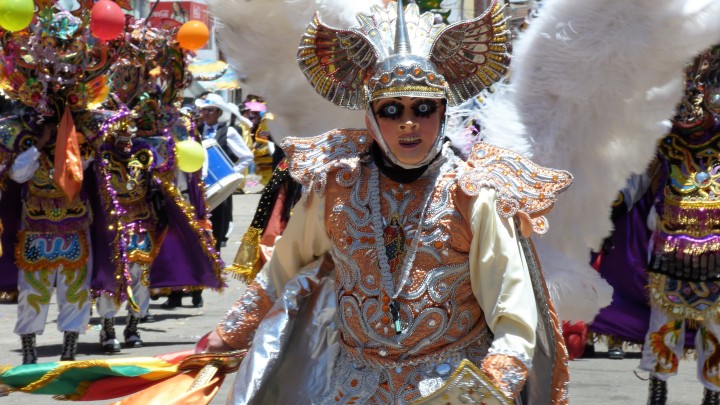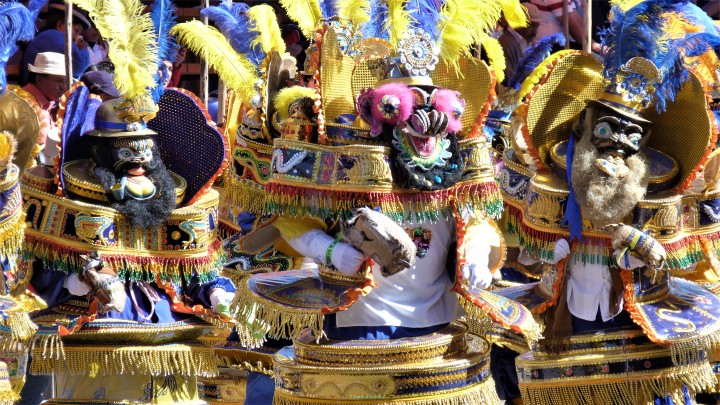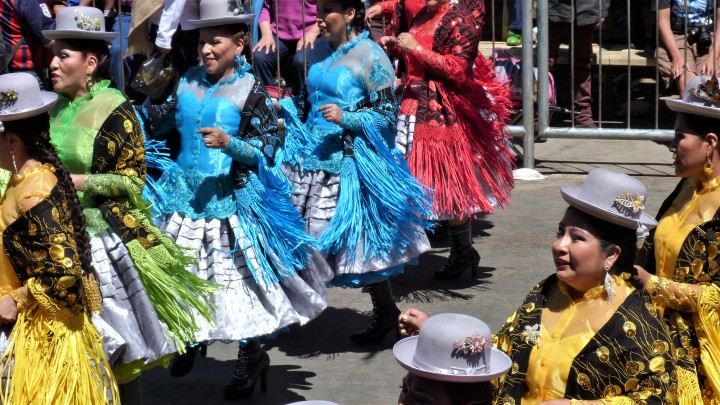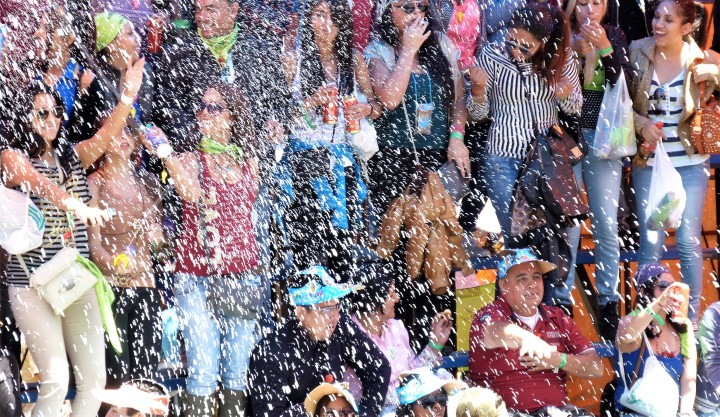
Carnival in Sucre was a blast. Carnival in Oruro was completely over the top.
For most of the year Oruro is a grim mining town with nothing much to recommend it, but a week before Lent it explodes into a frenetic fiesta of colour and music. It’s the most raucous and outrageous party of all. Aida urged us to go, telling us it was ‘different’. She though, was content to watch it on the TV. We dithered; wandering about the cost – hotels put up their prices five-fold – and worrying about all that water-throwing. Finally, we bit the bullet, booked a hotel and seats for the procession, and off we went.
‘What time does the Entrada begin’? I asked the man in the hotel lobby on the Saturday morning. He nodded towards the street, took my elbow, and leading me outside, pointed to a handful of devils gyrating down the road. It was barely 07.00. There were no spectators, no fanfare, no excitement. We found our seats and waited. I can’t say when it all kicked off. Throughout the morning, the trickle became a stream, the stream a river, and by lunchtime the stands were full and the dancers and bands were in full flood. Representations of Lucifer and St. Michael followed by hundreds of devils, who rotated and stepped, ducked and dived in a blaze of vibrant colour and embroidered costumes, all proceeded and followed by brass-bands. Staring out from behind masks with long twisted horns, and popping eyes, adorned with lizards and snakes, men assumed demonic proportions. The sun burned, and Dante’s Inferno seemed close by. ‘She-Devils’ danced amongst the demons. Temptresses in short skirts, with long eyelashes, red lips and flowing blonde hair. It’s a heady mix of Christian morality and Andean folklore. Archangel Michael triumphs over Lucifer, but the dance is also a celebration of the devil in the form of Huari, a pre-Columbian god of the underworld. It’s this god who owns the mineral wealth of the mines surrounding the town, and the miners dance to honour him.





A wealth of troupes follow behind the devils, each with their own costume and story – and musicians. Always the musicians. There were Incas; wild tribes of the Amazons, with feathered headdresses; Morenadas, faces blacked to represent the African slaves the Spanish bought to work the mines; llama herders, Spanish senoritas, cabelleros and cholitas. Each region and all of Bolivian history, has a place in the parade. The scale of it all was staggering. For hour after hour the dancers passed, cholitas in high-heeled suede boots, cabelleros flourishing sombreros, devils prancing, trumpets blazing, clapping, stomping, jumping and leaping. They just kept coming. Thirty-five thousand of them. For twenty four hours. Always smiling. It’s considered a sacred religious duty to dance. Rehearsals take place every Sunday from November onwards, and dancers promise to dance for three consecutive years.








The crowd, fuelled by alcohol, grew wilder as the day progressed. Cheering the dancer’s best moves, shrieks and cries grew to a crescendo, and spray foam showered us and everyone else like champagne bursting from a bottle. We couldn’t even watch for 24 hours. In the early evening we snuck back to the hotel to sleep, lulled by the rhythmic banging of drums. The parade started outside our window, and in the cold early hours we got up to watch some more. More quiet now, but still dancing, still smiling. And on Sunday, they did it all over again.

This was one party we’re glad we didn’t miss.
Wow! This seems to be an out of this world experience.
LikeLike
It really was like that Megala. We were undecided for so long about whether we should go, and then we had the most awful accommodation. Jim got an electric shock from the shower! The whole thing was so vague – where/what time etc. – and then it blossomed into this colourful, fantastic fiesta. It was one of the most mind-blowing things I’ve ever been to.
LikeLiked by 2 people
Well that’s a whole other level, isn’t it. Be great to experience though. 😉
LikeLike
Ha ha, yep, this was carnival to the power 10!
LikeLike
Oh you got some fabulous photos! And I love the way you describe it. I can feel your slack-jawed excitement. It’s very very similar to the Candelaria festival we attended just over the border in Puno Peru – same traditions, same costumes. It goes on for 2 weeks and we attended for 10 days in Puno and even had press credentials. I remember hearing at the time we were there that the same festival would be going on in Oruro. It’s an extraordinary tradition. I couldn’t believe how lucky we were to get to see it.
Alison
LikeLike
Wow! How did you get press credentials. That would be a dream.
LikeLike
Fantastic! A true spectacle.
Take care —
Neil Scheinin
LikeLiked by 1 person
Thanks Neil!
LikeLike
You got marvelous photos with you, Tracey. I’m sure you enjoy your time there as in enjoyed your stories. It’s indeed colorful carnival..
LikeLiked by 1 person
Thank you so much Nurul.
LikeLike
Wonderful photos that you managed to capture and as well your descriptions are very evocative and made us feel as though we were there with you! Wow what a carnival! I love all the different costumes and masks. I can only begin to imagine how it would be to hear the music as well. Am sure you were happy you made the effort to be there!
Peta
LikeLike
Thanks so much Peta. We’re so glad we did this. Think it was one of the best things we’ve ever experienced.
LikeLike
I’d never heard of this carnival, but your post really makes me feel like I was there! I think I say this every time, but this is beautifully written and I love the photos as well.
LikeLike
Thanks Dee. I tried to comment on your latest post but could not – got a message about being a robot!!! (which makes me laugh just to think about it).
LikeLike
I’ve never thought about travelling here. but now seeing your amazing pictures. I think I’ve got to add Oruro to my list. Thank you for sharing.
LikeLike
Thank you. Anywhere in Bolivia is worth a visit – it’s a fantastic country.
LikeLiked by 1 person
It’s on my trip list now, thank you for sharing.
LikeLike